CIPD Level 5 CHR Assignment: HR Agenda and Business Analysis
VerifiedAdded on 2022/10/02
|23
|5799
|2
Report
AI Summary
This report, a CIPD Level 5 CHR assignment, delves into the multifaceted role of Human Resources within an organization, specifically focusing on a non-profit entity named 'the Charity'. The report meticulously assesses various factors influencing an organization's business and HR functions, including government policies, globalization, and socio-demographic trends. It analyzes the forces shaping the HR agenda, comparing analytical tools like SWOT and PESTLE for business environment assessment. Furthermore, the report examines the key stages in strategy formulation, the implementation process, and HR's pivotal role in business ethics, accountability, and performance evaluation. It also explores HR's contribution to business planning, change management, and the utilization of diverse business and contextual data sources for effective planning purposes. The Ulrich Model is used to demonstrate the impact of HR functions on the HR agenda. The report provides a comprehensive overview of the strategic importance of HR in navigating the complexities of the modern business landscape, especially within the context of a non-profit organization and its unique challenges. The report also discusses the challenges of the centralised HR system in the organisation.
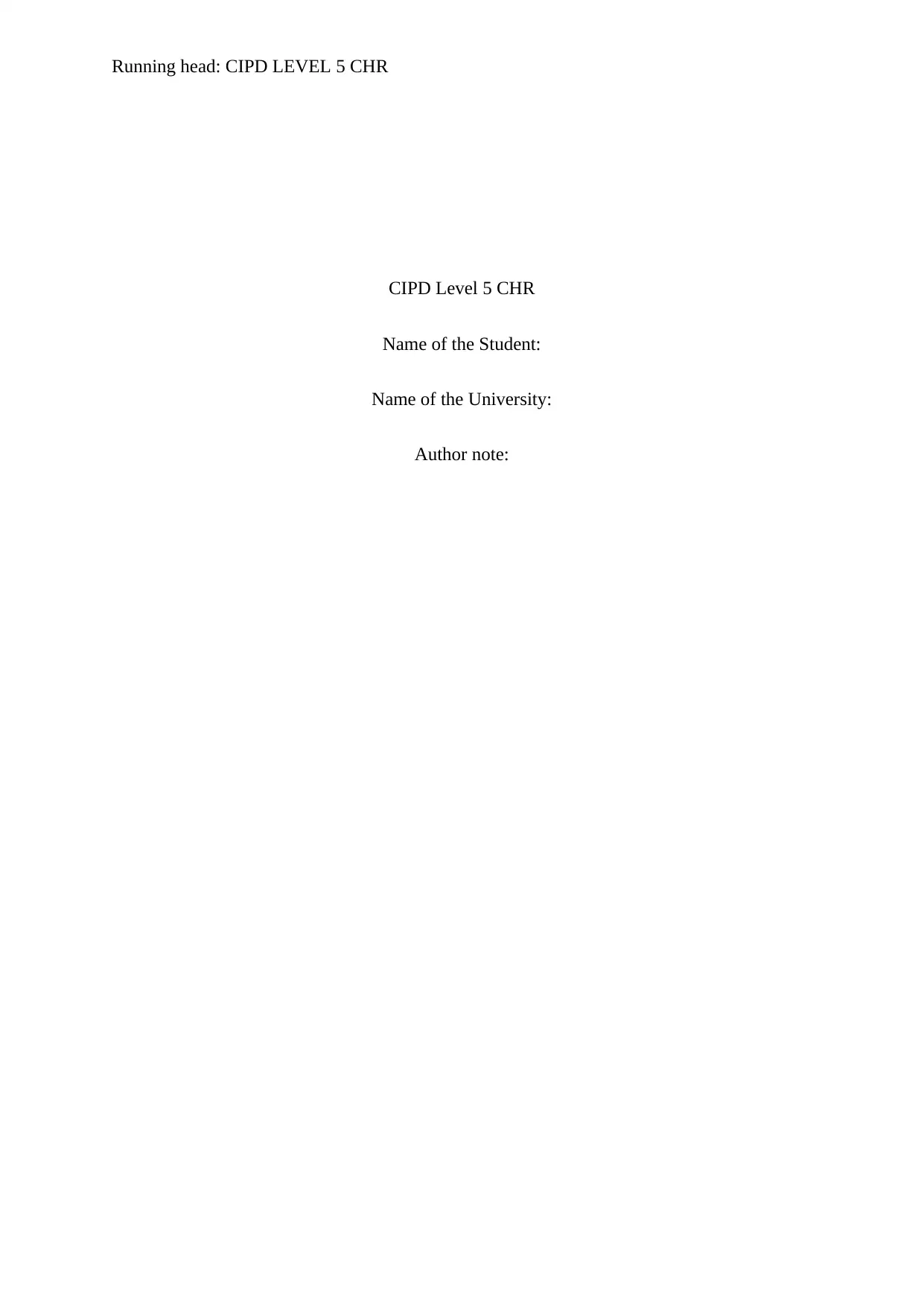
Running head: CIPD LEVEL 5 CHR
CIPD Level 5 CHR
Name of the Student:
Name of the University:
Author note:
CIPD Level 5 CHR
Name of the Student:
Name of the University:
Author note:
Paraphrase This Document
Need a fresh take? Get an instant paraphrase of this document with our AI Paraphraser
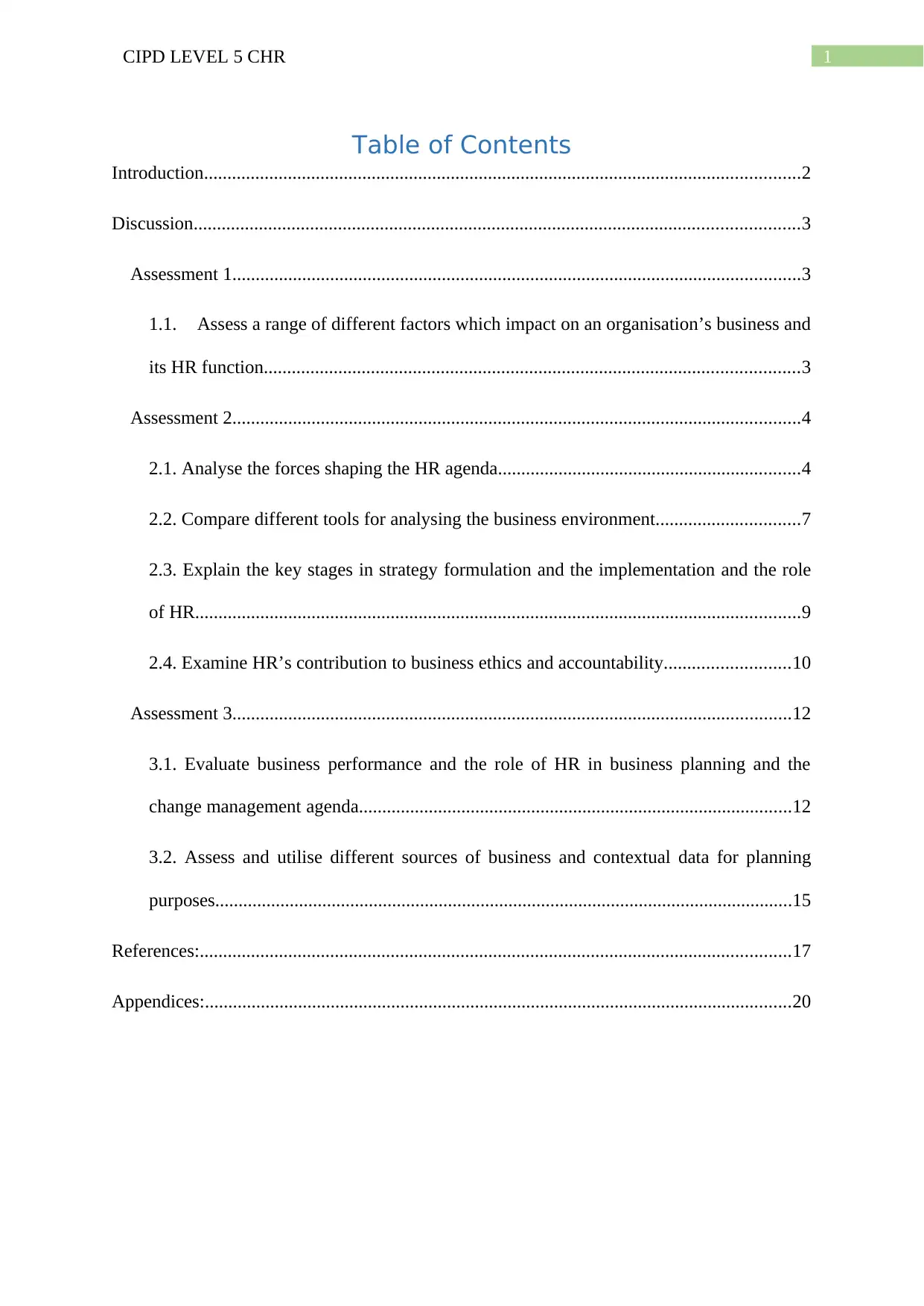
1CIPD LEVEL 5 CHR
Table of Contents
Introduction................................................................................................................................2
Discussion..................................................................................................................................3
Assessment 1..........................................................................................................................3
1.1. Assess a range of different factors which impact on an organisation’s business and
its HR function...................................................................................................................3
Assessment 2..........................................................................................................................4
2.1. Analyse the forces shaping the HR agenda.................................................................4
2.2. Compare different tools for analysing the business environment...............................7
2.3. Explain the key stages in strategy formulation and the implementation and the role
of HR..................................................................................................................................9
2.4. Examine HR’s contribution to business ethics and accountability...........................10
Assessment 3........................................................................................................................12
3.1. Evaluate business performance and the role of HR in business planning and the
change management agenda.............................................................................................12
3.2. Assess and utilise different sources of business and contextual data for planning
purposes............................................................................................................................15
References:...............................................................................................................................17
Appendices:..............................................................................................................................20
Table of Contents
Introduction................................................................................................................................2
Discussion..................................................................................................................................3
Assessment 1..........................................................................................................................3
1.1. Assess a range of different factors which impact on an organisation’s business and
its HR function...................................................................................................................3
Assessment 2..........................................................................................................................4
2.1. Analyse the forces shaping the HR agenda.................................................................4
2.2. Compare different tools for analysing the business environment...............................7
2.3. Explain the key stages in strategy formulation and the implementation and the role
of HR..................................................................................................................................9
2.4. Examine HR’s contribution to business ethics and accountability...........................10
Assessment 3........................................................................................................................12
3.1. Evaluate business performance and the role of HR in business planning and the
change management agenda.............................................................................................12
3.2. Assess and utilise different sources of business and contextual data for planning
purposes............................................................................................................................15
References:...............................................................................................................................17
Appendices:..............................................................................................................................20
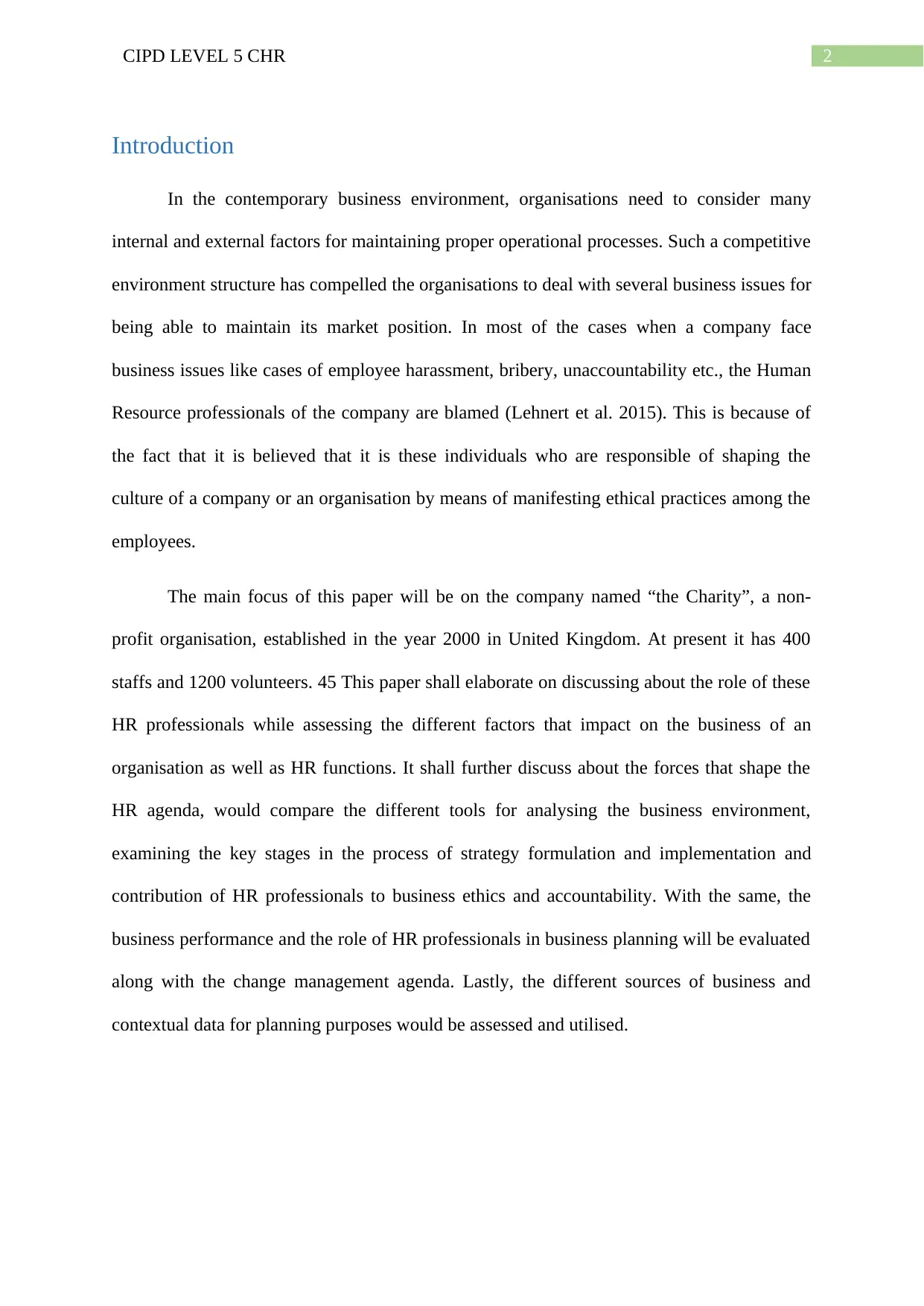
2CIPD LEVEL 5 CHR
Introduction
In the contemporary business environment, organisations need to consider many
internal and external factors for maintaining proper operational processes. Such a competitive
environment structure has compelled the organisations to deal with several business issues for
being able to maintain its market position. In most of the cases when a company face
business issues like cases of employee harassment, bribery, unaccountability etc., the Human
Resource professionals of the company are blamed (Lehnert et al. 2015). This is because of
the fact that it is believed that it is these individuals who are responsible of shaping the
culture of a company or an organisation by means of manifesting ethical practices among the
employees.
The main focus of this paper will be on the company named “the Charity”, a non-
profit organisation, established in the year 2000 in United Kingdom. At present it has 400
staffs and 1200 volunteers. 45 This paper shall elaborate on discussing about the role of these
HR professionals while assessing the different factors that impact on the business of an
organisation as well as HR functions. It shall further discuss about the forces that shape the
HR agenda, would compare the different tools for analysing the business environment,
examining the key stages in the process of strategy formulation and implementation and
contribution of HR professionals to business ethics and accountability. With the same, the
business performance and the role of HR professionals in business planning will be evaluated
along with the change management agenda. Lastly, the different sources of business and
contextual data for planning purposes would be assessed and utilised.
Introduction
In the contemporary business environment, organisations need to consider many
internal and external factors for maintaining proper operational processes. Such a competitive
environment structure has compelled the organisations to deal with several business issues for
being able to maintain its market position. In most of the cases when a company face
business issues like cases of employee harassment, bribery, unaccountability etc., the Human
Resource professionals of the company are blamed (Lehnert et al. 2015). This is because of
the fact that it is believed that it is these individuals who are responsible of shaping the
culture of a company or an organisation by means of manifesting ethical practices among the
employees.
The main focus of this paper will be on the company named “the Charity”, a non-
profit organisation, established in the year 2000 in United Kingdom. At present it has 400
staffs and 1200 volunteers. 45 This paper shall elaborate on discussing about the role of these
HR professionals while assessing the different factors that impact on the business of an
organisation as well as HR functions. It shall further discuss about the forces that shape the
HR agenda, would compare the different tools for analysing the business environment,
examining the key stages in the process of strategy formulation and implementation and
contribution of HR professionals to business ethics and accountability. With the same, the
business performance and the role of HR professionals in business planning will be evaluated
along with the change management agenda. Lastly, the different sources of business and
contextual data for planning purposes would be assessed and utilised.
⊘ This is a preview!⊘
Do you want full access?
Subscribe today to unlock all pages.

Trusted by 1+ million students worldwide
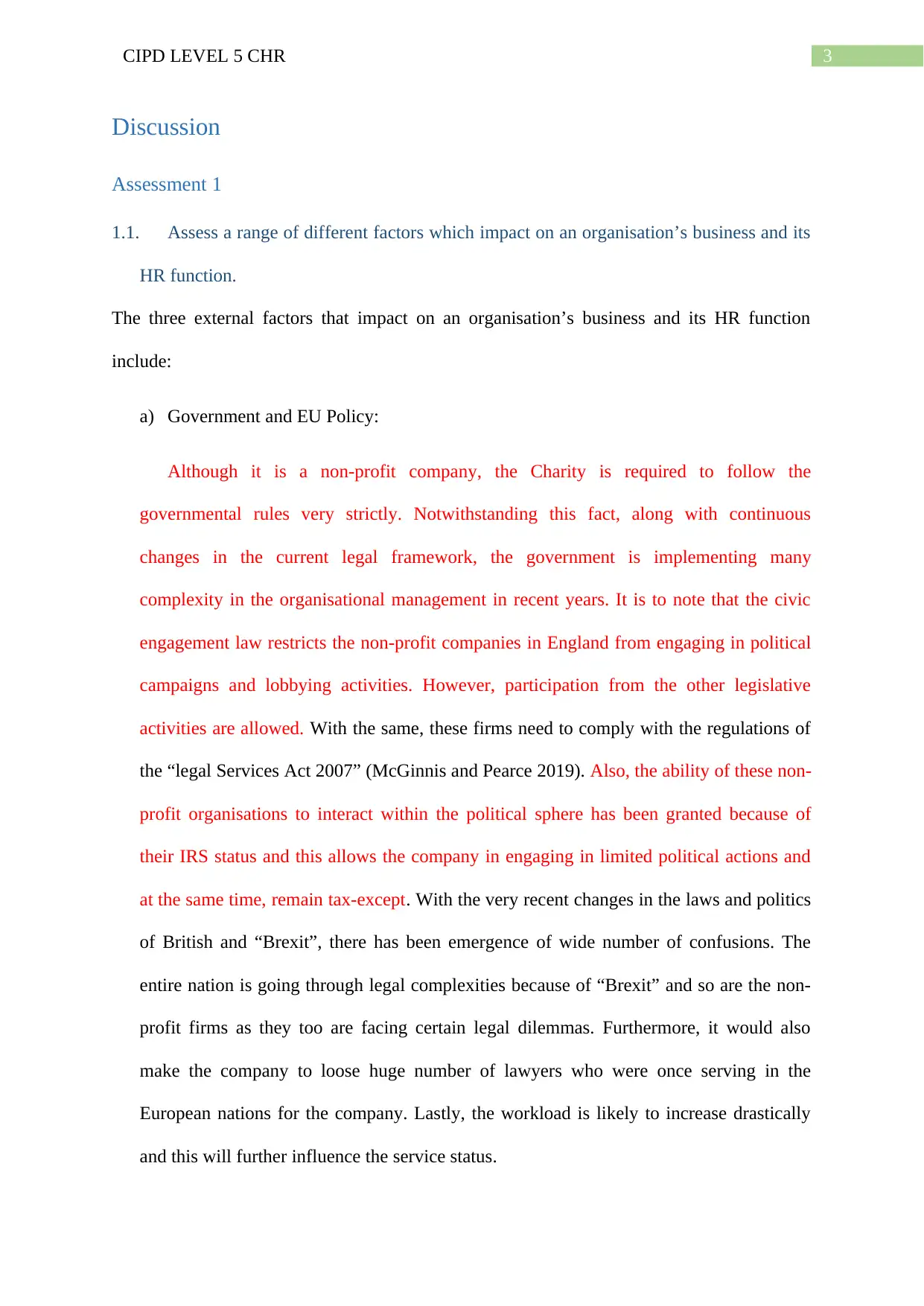
3CIPD LEVEL 5 CHR
Discussion
Assessment 1
1.1. Assess a range of different factors which impact on an organisation’s business and its
HR function.
The three external factors that impact on an organisation’s business and its HR function
include:
a) Government and EU Policy:
Although it is a non-profit company, the Charity is required to follow the
governmental rules very strictly. Notwithstanding this fact, along with continuous
changes in the current legal framework, the government is implementing many
complexity in the organisational management in recent years. It is to note that the civic
engagement law restricts the non-profit companies in England from engaging in political
campaigns and lobbying activities. However, participation from the other legislative
activities are allowed. With the same, these firms need to comply with the regulations of
the “legal Services Act 2007” (McGinnis and Pearce 2019). Also, the ability of these non-
profit organisations to interact within the political sphere has been granted because of
their IRS status and this allows the company in engaging in limited political actions and
at the same time, remain tax-except. With the very recent changes in the laws and politics
of British and “Brexit”, there has been emergence of wide number of confusions. The
entire nation is going through legal complexities because of “Brexit” and so are the non-
profit firms as they too are facing certain legal dilemmas. Furthermore, it would also
make the company to loose huge number of lawyers who were once serving in the
European nations for the company. Lastly, the workload is likely to increase drastically
and this will further influence the service status.
Discussion
Assessment 1
1.1. Assess a range of different factors which impact on an organisation’s business and its
HR function.
The three external factors that impact on an organisation’s business and its HR function
include:
a) Government and EU Policy:
Although it is a non-profit company, the Charity is required to follow the
governmental rules very strictly. Notwithstanding this fact, along with continuous
changes in the current legal framework, the government is implementing many
complexity in the organisational management in recent years. It is to note that the civic
engagement law restricts the non-profit companies in England from engaging in political
campaigns and lobbying activities. However, participation from the other legislative
activities are allowed. With the same, these firms need to comply with the regulations of
the “legal Services Act 2007” (McGinnis and Pearce 2019). Also, the ability of these non-
profit organisations to interact within the political sphere has been granted because of
their IRS status and this allows the company in engaging in limited political actions and
at the same time, remain tax-except. With the very recent changes in the laws and politics
of British and “Brexit”, there has been emergence of wide number of confusions. The
entire nation is going through legal complexities because of “Brexit” and so are the non-
profit firms as they too are facing certain legal dilemmas. Furthermore, it would also
make the company to loose huge number of lawyers who were once serving in the
European nations for the company. Lastly, the workload is likely to increase drastically
and this will further influence the service status.
Paraphrase This Document
Need a fresh take? Get an instant paraphrase of this document with our AI Paraphraser
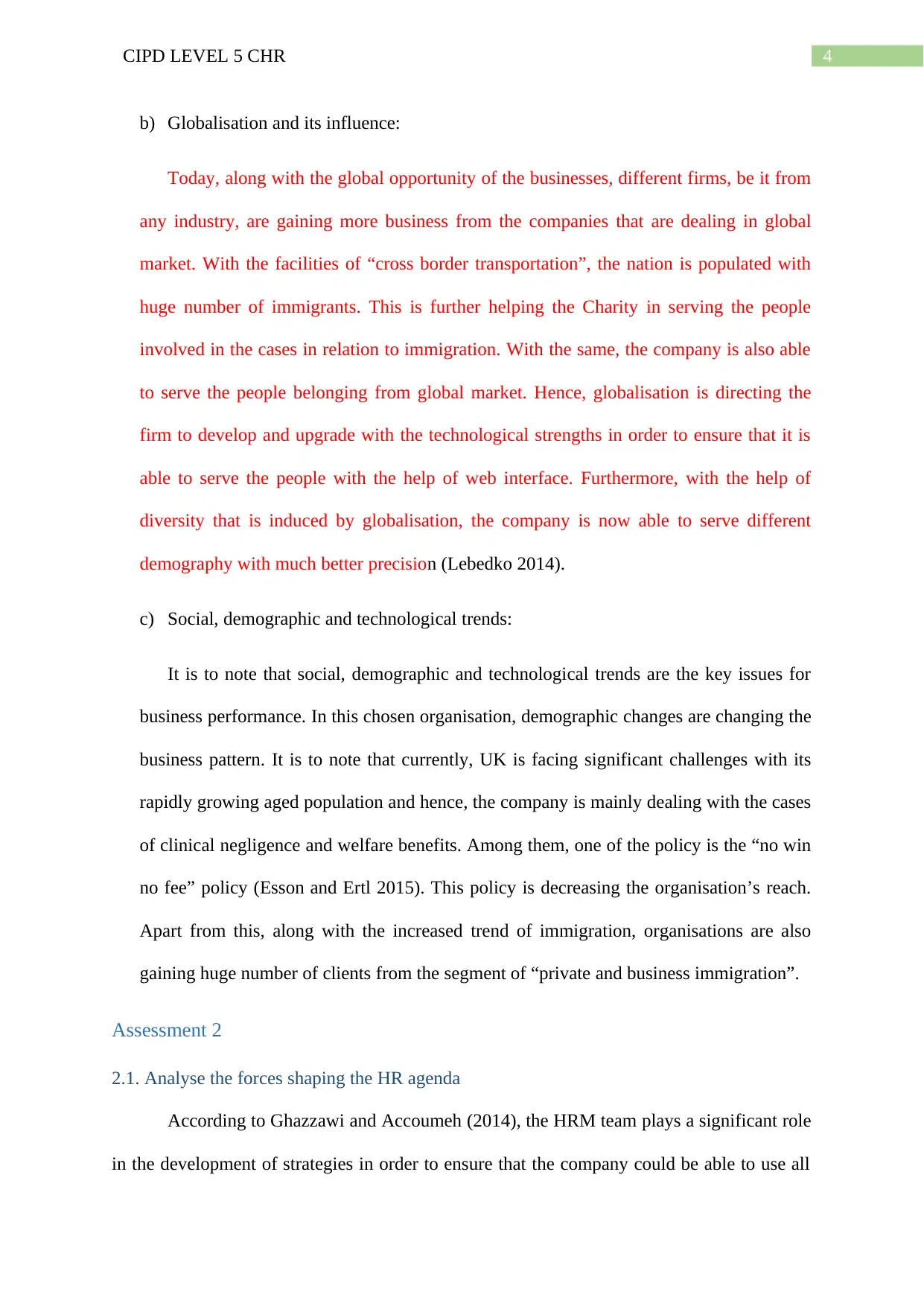
4CIPD LEVEL 5 CHR
b) Globalisation and its influence:
Today, along with the global opportunity of the businesses, different firms, be it from
any industry, are gaining more business from the companies that are dealing in global
market. With the facilities of “cross border transportation”, the nation is populated with
huge number of immigrants. This is further helping the Charity in serving the people
involved in the cases in relation to immigration. With the same, the company is also able
to serve the people belonging from global market. Hence, globalisation is directing the
firm to develop and upgrade with the technological strengths in order to ensure that it is
able to serve the people with the help of web interface. Furthermore, with the help of
diversity that is induced by globalisation, the company is now able to serve different
demography with much better precision (Lebedko 2014).
c) Social, demographic and technological trends:
It is to note that social, demographic and technological trends are the key issues for
business performance. In this chosen organisation, demographic changes are changing the
business pattern. It is to note that currently, UK is facing significant challenges with its
rapidly growing aged population and hence, the company is mainly dealing with the cases
of clinical negligence and welfare benefits. Among them, one of the policy is the “no win
no fee” policy (Esson and Ertl 2015). This policy is decreasing the organisation’s reach.
Apart from this, along with the increased trend of immigration, organisations are also
gaining huge number of clients from the segment of “private and business immigration”.
Assessment 2
2.1. Analyse the forces shaping the HR agenda
According to Ghazzawi and Accoumeh (2014), the HRM team plays a significant role
in the development of strategies in order to ensure that the company could be able to use all
b) Globalisation and its influence:
Today, along with the global opportunity of the businesses, different firms, be it from
any industry, are gaining more business from the companies that are dealing in global
market. With the facilities of “cross border transportation”, the nation is populated with
huge number of immigrants. This is further helping the Charity in serving the people
involved in the cases in relation to immigration. With the same, the company is also able
to serve the people belonging from global market. Hence, globalisation is directing the
firm to develop and upgrade with the technological strengths in order to ensure that it is
able to serve the people with the help of web interface. Furthermore, with the help of
diversity that is induced by globalisation, the company is now able to serve different
demography with much better precision (Lebedko 2014).
c) Social, demographic and technological trends:
It is to note that social, demographic and technological trends are the key issues for
business performance. In this chosen organisation, demographic changes are changing the
business pattern. It is to note that currently, UK is facing significant challenges with its
rapidly growing aged population and hence, the company is mainly dealing with the cases
of clinical negligence and welfare benefits. Among them, one of the policy is the “no win
no fee” policy (Esson and Ertl 2015). This policy is decreasing the organisation’s reach.
Apart from this, along with the increased trend of immigration, organisations are also
gaining huge number of clients from the segment of “private and business immigration”.
Assessment 2
2.1. Analyse the forces shaping the HR agenda
According to Ghazzawi and Accoumeh (2014), the HRM team plays a significant role
in the development of strategies in order to ensure that the company could be able to use all
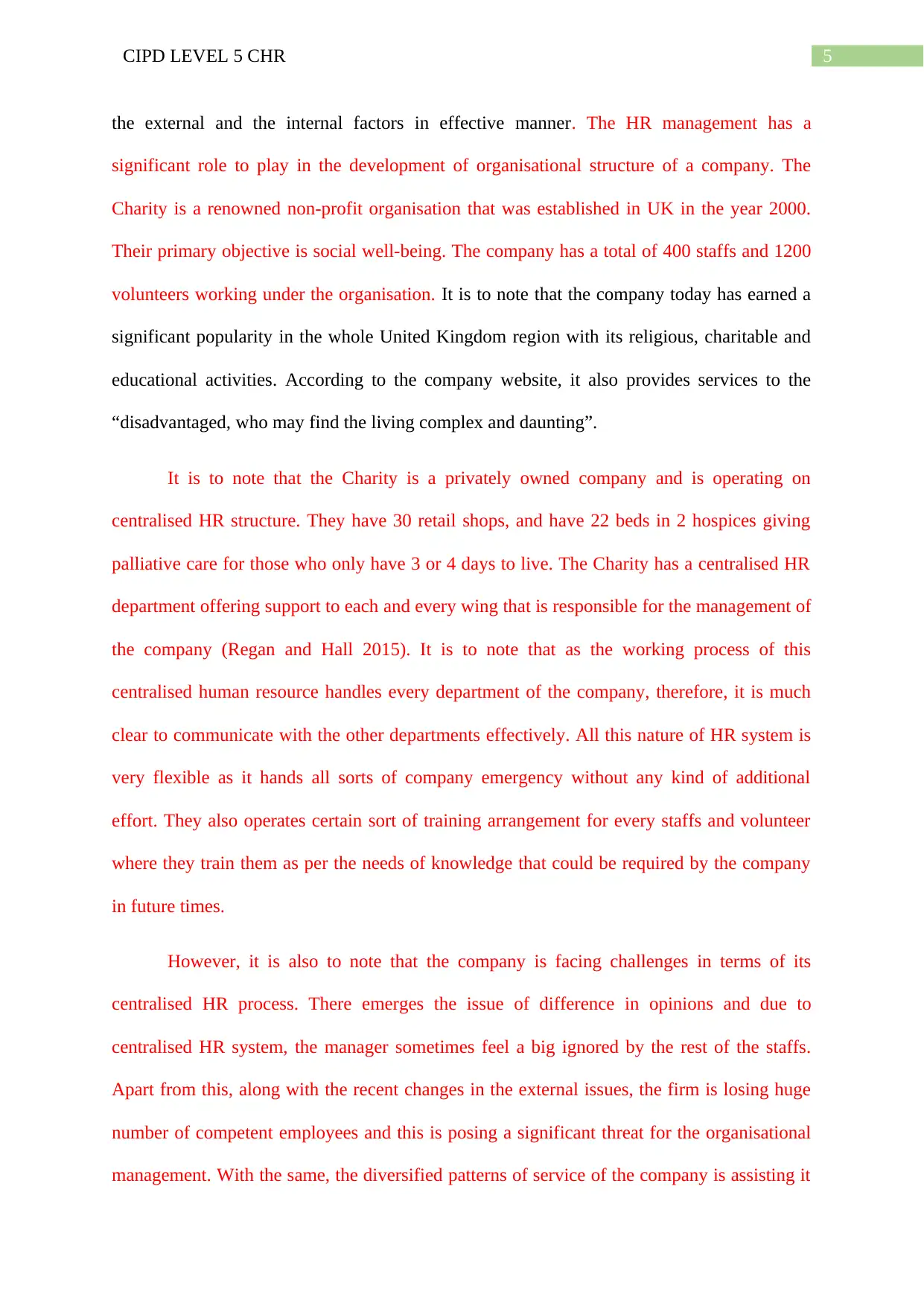
5CIPD LEVEL 5 CHR
the external and the internal factors in effective manner. The HR management has a
significant role to play in the development of organisational structure of a company. The
Charity is a renowned non-profit organisation that was established in UK in the year 2000.
Their primary objective is social well-being. The company has a total of 400 staffs and 1200
volunteers working under the organisation. It is to note that the company today has earned a
significant popularity in the whole United Kingdom region with its religious, charitable and
educational activities. According to the company website, it also provides services to the
“disadvantaged, who may find the living complex and daunting”.
It is to note that the Charity is a privately owned company and is operating on
centralised HR structure. They have 30 retail shops, and have 22 beds in 2 hospices giving
palliative care for those who only have 3 or 4 days to live. The Charity has a centralised HR
department offering support to each and every wing that is responsible for the management of
the company (Regan and Hall 2015). It is to note that as the working process of this
centralised human resource handles every department of the company, therefore, it is much
clear to communicate with the other departments effectively. All this nature of HR system is
very flexible as it hands all sorts of company emergency without any kind of additional
effort. They also operates certain sort of training arrangement for every staffs and volunteer
where they train them as per the needs of knowledge that could be required by the company
in future times.
However, it is also to note that the company is facing challenges in terms of its
centralised HR process. There emerges the issue of difference in opinions and due to
centralised HR system, the manager sometimes feel a big ignored by the rest of the staffs.
Apart from this, along with the recent changes in the external issues, the firm is losing huge
number of competent employees and this is posing a significant threat for the organisational
management. With the same, the diversified patterns of service of the company is assisting it
the external and the internal factors in effective manner. The HR management has a
significant role to play in the development of organisational structure of a company. The
Charity is a renowned non-profit organisation that was established in UK in the year 2000.
Their primary objective is social well-being. The company has a total of 400 staffs and 1200
volunteers working under the organisation. It is to note that the company today has earned a
significant popularity in the whole United Kingdom region with its religious, charitable and
educational activities. According to the company website, it also provides services to the
“disadvantaged, who may find the living complex and daunting”.
It is to note that the Charity is a privately owned company and is operating on
centralised HR structure. They have 30 retail shops, and have 22 beds in 2 hospices giving
palliative care for those who only have 3 or 4 days to live. The Charity has a centralised HR
department offering support to each and every wing that is responsible for the management of
the company (Regan and Hall 2015). It is to note that as the working process of this
centralised human resource handles every department of the company, therefore, it is much
clear to communicate with the other departments effectively. All this nature of HR system is
very flexible as it hands all sorts of company emergency without any kind of additional
effort. They also operates certain sort of training arrangement for every staffs and volunteer
where they train them as per the needs of knowledge that could be required by the company
in future times.
However, it is also to note that the company is facing challenges in terms of its
centralised HR process. There emerges the issue of difference in opinions and due to
centralised HR system, the manager sometimes feel a big ignored by the rest of the staffs.
Apart from this, along with the recent changes in the external issues, the firm is losing huge
number of competent employees and this is posing a significant threat for the organisational
management. With the same, the diversified patterns of service of the company is assisting it
⊘ This is a preview!⊘
Do you want full access?
Subscribe today to unlock all pages.

Trusted by 1+ million students worldwide

6CIPD LEVEL 5 CHR
in serving huge number of client bases. Notwithstanding this fact, along with huge team of
management, the company is facing challenges in terms of interdepartmental co-ordination.
All these factors are leading the company to opt for Human Resource agenda.
How model of HR function impact the HR agenda
The Ulrich Model
It is to note that HR model connects the HR strategy, the goals and objectives along
with HR processes and jobs into an operating model. It defined the important roles and
responsibility of the HR. Every change of HR agenda needs to begin with the change of HR
model. The four HR roles by Dave Ulrich are change agent, administration expert, employee
advocate and HR business partner (See Appendix 1).
a) HR Business Partner- It is strategic role of HR. In my organisation, the Charity, it is
the role of HR to build strategic partnership and collaborations with the dedicated
internal clients of our company like our staffs. He is the one to represent the HR
system and advertise the HR services in the company. He also influence positively our
organisation design and identified the talents that are suitable for working for a non-
profit organisation like ours. He also facilitates tough meetings and find out win-win
solution.
b) As a change agent- Our HR participates in the teams of change management in our
company and takes the responsibility of communicating about the changes internally
and gaining trust of the staffs and volunteers. He also plans training sessions, internal
communication and continuously collects feedbacks from the staffs.
c) Administration expert- It is a transactional role of HR in our firm. He is the one to
implement all the requirements that evolve from the process of change in regulation,
work and safety rules and legislations.
in serving huge number of client bases. Notwithstanding this fact, along with huge team of
management, the company is facing challenges in terms of interdepartmental co-ordination.
All these factors are leading the company to opt for Human Resource agenda.
How model of HR function impact the HR agenda
The Ulrich Model
It is to note that HR model connects the HR strategy, the goals and objectives along
with HR processes and jobs into an operating model. It defined the important roles and
responsibility of the HR. Every change of HR agenda needs to begin with the change of HR
model. The four HR roles by Dave Ulrich are change agent, administration expert, employee
advocate and HR business partner (See Appendix 1).
a) HR Business Partner- It is strategic role of HR. In my organisation, the Charity, it is
the role of HR to build strategic partnership and collaborations with the dedicated
internal clients of our company like our staffs. He is the one to represent the HR
system and advertise the HR services in the company. He also influence positively our
organisation design and identified the talents that are suitable for working for a non-
profit organisation like ours. He also facilitates tough meetings and find out win-win
solution.
b) As a change agent- Our HR participates in the teams of change management in our
company and takes the responsibility of communicating about the changes internally
and gaining trust of the staffs and volunteers. He also plans training sessions, internal
communication and continuously collects feedbacks from the staffs.
c) Administration expert- It is a transactional role of HR in our firm. He is the one to
implement all the requirements that evolve from the process of change in regulation,
work and safety rules and legislations.
Paraphrase This Document
Need a fresh take? Get an instant paraphrase of this document with our AI Paraphraser
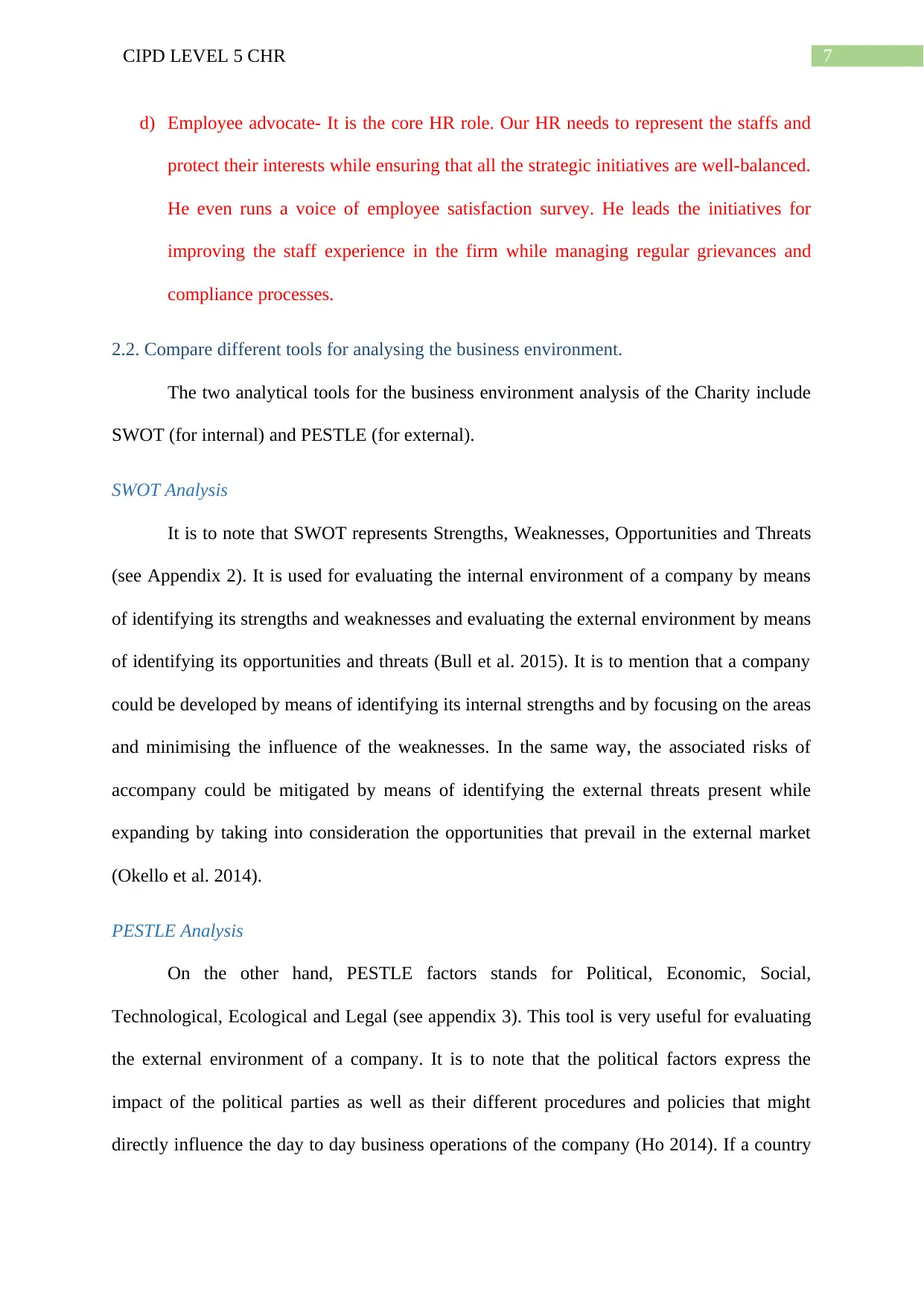
7CIPD LEVEL 5 CHR
d) Employee advocate- It is the core HR role. Our HR needs to represent the staffs and
protect their interests while ensuring that all the strategic initiatives are well-balanced.
He even runs a voice of employee satisfaction survey. He leads the initiatives for
improving the staff experience in the firm while managing regular grievances and
compliance processes.
2.2. Compare different tools for analysing the business environment.
The two analytical tools for the business environment analysis of the Charity include
SWOT (for internal) and PESTLE (for external).
SWOT Analysis
It is to note that SWOT represents Strengths, Weaknesses, Opportunities and Threats
(see Appendix 2). It is used for evaluating the internal environment of a company by means
of identifying its strengths and weaknesses and evaluating the external environment by means
of identifying its opportunities and threats (Bull et al. 2015). It is to mention that a company
could be developed by means of identifying its internal strengths and by focusing on the areas
and minimising the influence of the weaknesses. In the same way, the associated risks of
accompany could be mitigated by means of identifying the external threats present while
expanding by taking into consideration the opportunities that prevail in the external market
(Okello et al. 2014).
PESTLE Analysis
On the other hand, PESTLE factors stands for Political, Economic, Social,
Technological, Ecological and Legal (see appendix 3). This tool is very useful for evaluating
the external environment of a company. It is to note that the political factors express the
impact of the political parties as well as their different procedures and policies that might
directly influence the day to day business operations of the company (Ho 2014). If a country
d) Employee advocate- It is the core HR role. Our HR needs to represent the staffs and
protect their interests while ensuring that all the strategic initiatives are well-balanced.
He even runs a voice of employee satisfaction survey. He leads the initiatives for
improving the staff experience in the firm while managing regular grievances and
compliance processes.
2.2. Compare different tools for analysing the business environment.
The two analytical tools for the business environment analysis of the Charity include
SWOT (for internal) and PESTLE (for external).
SWOT Analysis
It is to note that SWOT represents Strengths, Weaknesses, Opportunities and Threats
(see Appendix 2). It is used for evaluating the internal environment of a company by means
of identifying its strengths and weaknesses and evaluating the external environment by means
of identifying its opportunities and threats (Bull et al. 2015). It is to mention that a company
could be developed by means of identifying its internal strengths and by focusing on the areas
and minimising the influence of the weaknesses. In the same way, the associated risks of
accompany could be mitigated by means of identifying the external threats present while
expanding by taking into consideration the opportunities that prevail in the external market
(Okello et al. 2014).
PESTLE Analysis
On the other hand, PESTLE factors stands for Political, Economic, Social,
Technological, Ecological and Legal (see appendix 3). This tool is very useful for evaluating
the external environment of a company. It is to note that the political factors express the
impact of the political parties as well as their different procedures and policies that might
directly influence the day to day business operations of the company (Ho 2014). If a country
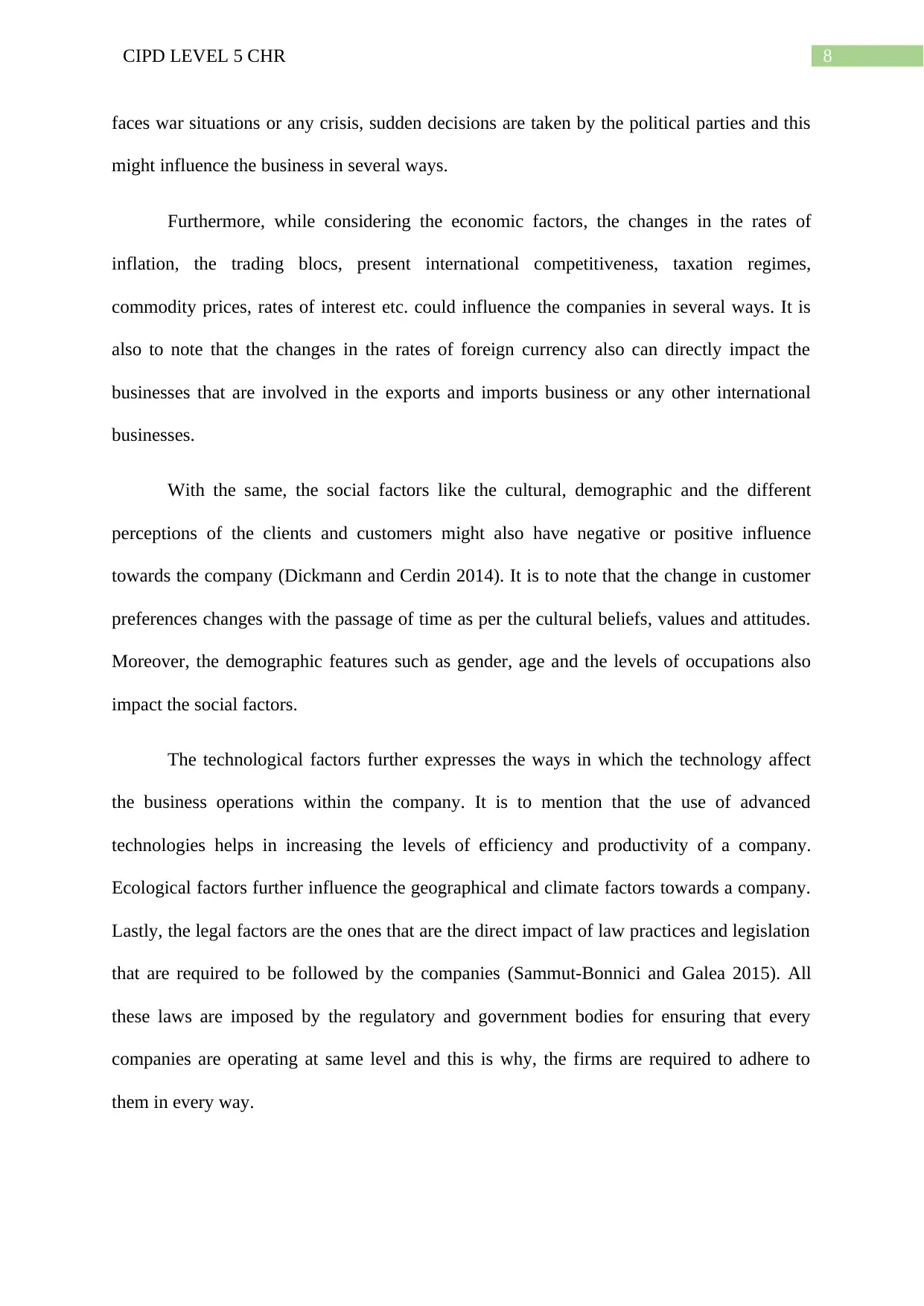
8CIPD LEVEL 5 CHR
faces war situations or any crisis, sudden decisions are taken by the political parties and this
might influence the business in several ways.
Furthermore, while considering the economic factors, the changes in the rates of
inflation, the trading blocs, present international competitiveness, taxation regimes,
commodity prices, rates of interest etc. could influence the companies in several ways. It is
also to note that the changes in the rates of foreign currency also can directly impact the
businesses that are involved in the exports and imports business or any other international
businesses.
With the same, the social factors like the cultural, demographic and the different
perceptions of the clients and customers might also have negative or positive influence
towards the company (Dickmann and Cerdin 2014). It is to note that the change in customer
preferences changes with the passage of time as per the cultural beliefs, values and attitudes.
Moreover, the demographic features such as gender, age and the levels of occupations also
impact the social factors.
The technological factors further expresses the ways in which the technology affect
the business operations within the company. It is to mention that the use of advanced
technologies helps in increasing the levels of efficiency and productivity of a company.
Ecological factors further influence the geographical and climate factors towards a company.
Lastly, the legal factors are the ones that are the direct impact of law practices and legislation
that are required to be followed by the companies (Sammut-Bonnici and Galea 2015). All
these laws are imposed by the regulatory and government bodies for ensuring that every
companies are operating at same level and this is why, the firms are required to adhere to
them in every way.
faces war situations or any crisis, sudden decisions are taken by the political parties and this
might influence the business in several ways.
Furthermore, while considering the economic factors, the changes in the rates of
inflation, the trading blocs, present international competitiveness, taxation regimes,
commodity prices, rates of interest etc. could influence the companies in several ways. It is
also to note that the changes in the rates of foreign currency also can directly impact the
businesses that are involved in the exports and imports business or any other international
businesses.
With the same, the social factors like the cultural, demographic and the different
perceptions of the clients and customers might also have negative or positive influence
towards the company (Dickmann and Cerdin 2014). It is to note that the change in customer
preferences changes with the passage of time as per the cultural beliefs, values and attitudes.
Moreover, the demographic features such as gender, age and the levels of occupations also
impact the social factors.
The technological factors further expresses the ways in which the technology affect
the business operations within the company. It is to mention that the use of advanced
technologies helps in increasing the levels of efficiency and productivity of a company.
Ecological factors further influence the geographical and climate factors towards a company.
Lastly, the legal factors are the ones that are the direct impact of law practices and legislation
that are required to be followed by the companies (Sammut-Bonnici and Galea 2015). All
these laws are imposed by the regulatory and government bodies for ensuring that every
companies are operating at same level and this is why, the firms are required to adhere to
them in every way.
⊘ This is a preview!⊘
Do you want full access?
Subscribe today to unlock all pages.

Trusted by 1+ million students worldwide
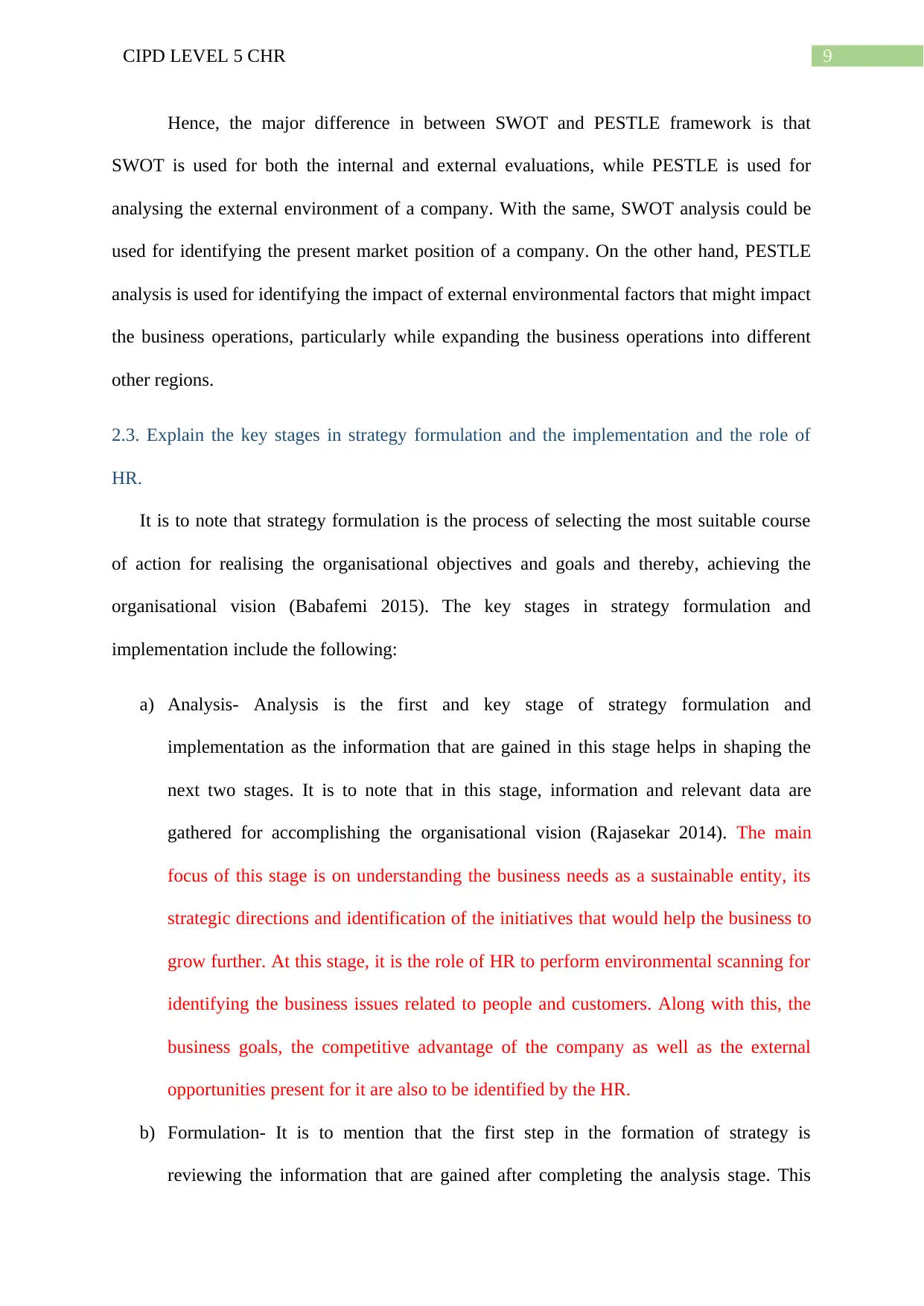
9CIPD LEVEL 5 CHR
Hence, the major difference in between SWOT and PESTLE framework is that
SWOT is used for both the internal and external evaluations, while PESTLE is used for
analysing the external environment of a company. With the same, SWOT analysis could be
used for identifying the present market position of a company. On the other hand, PESTLE
analysis is used for identifying the impact of external environmental factors that might impact
the business operations, particularly while expanding the business operations into different
other regions.
2.3. Explain the key stages in strategy formulation and the implementation and the role of
HR.
It is to note that strategy formulation is the process of selecting the most suitable course
of action for realising the organisational objectives and goals and thereby, achieving the
organisational vision (Babafemi 2015). The key stages in strategy formulation and
implementation include the following:
a) Analysis- Analysis is the first and key stage of strategy formulation and
implementation as the information that are gained in this stage helps in shaping the
next two stages. It is to note that in this stage, information and relevant data are
gathered for accomplishing the organisational vision (Rajasekar 2014). The main
focus of this stage is on understanding the business needs as a sustainable entity, its
strategic directions and identification of the initiatives that would help the business to
grow further. At this stage, it is the role of HR to perform environmental scanning for
identifying the business issues related to people and customers. Along with this, the
business goals, the competitive advantage of the company as well as the external
opportunities present for it are also to be identified by the HR.
b) Formulation- It is to mention that the first step in the formation of strategy is
reviewing the information that are gained after completing the analysis stage. This
Hence, the major difference in between SWOT and PESTLE framework is that
SWOT is used for both the internal and external evaluations, while PESTLE is used for
analysing the external environment of a company. With the same, SWOT analysis could be
used for identifying the present market position of a company. On the other hand, PESTLE
analysis is used for identifying the impact of external environmental factors that might impact
the business operations, particularly while expanding the business operations into different
other regions.
2.3. Explain the key stages in strategy formulation and the implementation and the role of
HR.
It is to note that strategy formulation is the process of selecting the most suitable course
of action for realising the organisational objectives and goals and thereby, achieving the
organisational vision (Babafemi 2015). The key stages in strategy formulation and
implementation include the following:
a) Analysis- Analysis is the first and key stage of strategy formulation and
implementation as the information that are gained in this stage helps in shaping the
next two stages. It is to note that in this stage, information and relevant data are
gathered for accomplishing the organisational vision (Rajasekar 2014). The main
focus of this stage is on understanding the business needs as a sustainable entity, its
strategic directions and identification of the initiatives that would help the business to
grow further. At this stage, it is the role of HR to perform environmental scanning for
identifying the business issues related to people and customers. Along with this, the
business goals, the competitive advantage of the company as well as the external
opportunities present for it are also to be identified by the HR.
b) Formulation- It is to mention that the first step in the formation of strategy is
reviewing the information that are gained after completing the analysis stage. This
Paraphrase This Document
Need a fresh take? Get an instant paraphrase of this document with our AI Paraphraser
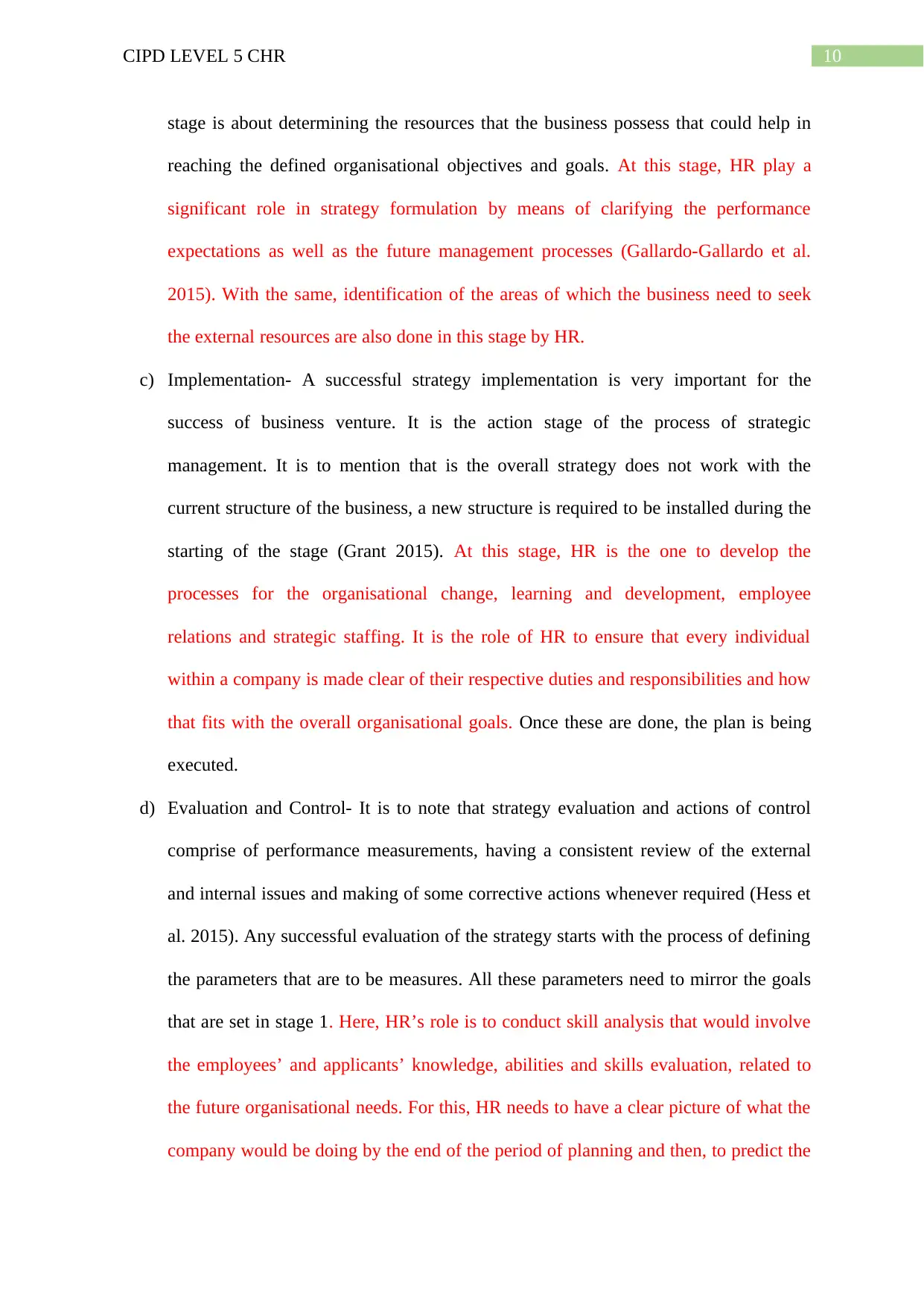
10CIPD LEVEL 5 CHR
stage is about determining the resources that the business possess that could help in
reaching the defined organisational objectives and goals. At this stage, HR play a
significant role in strategy formulation by means of clarifying the performance
expectations as well as the future management processes (Gallardo-Gallardo et al.
2015). With the same, identification of the areas of which the business need to seek
the external resources are also done in this stage by HR.
c) Implementation- A successful strategy implementation is very important for the
success of business venture. It is the action stage of the process of strategic
management. It is to mention that is the overall strategy does not work with the
current structure of the business, a new structure is required to be installed during the
starting of the stage (Grant 2015). At this stage, HR is the one to develop the
processes for the organisational change, learning and development, employee
relations and strategic staffing. It is the role of HR to ensure that every individual
within a company is made clear of their respective duties and responsibilities and how
that fits with the overall organisational goals. Once these are done, the plan is being
executed.
d) Evaluation and Control- It is to note that strategy evaluation and actions of control
comprise of performance measurements, having a consistent review of the external
and internal issues and making of some corrective actions whenever required (Hess et
al. 2015). Any successful evaluation of the strategy starts with the process of defining
the parameters that are to be measures. All these parameters need to mirror the goals
that are set in stage 1. Here, HR’s role is to conduct skill analysis that would involve
the employees’ and applicants’ knowledge, abilities and skills evaluation, related to
the future organisational needs. For this, HR needs to have a clear picture of what the
company would be doing by the end of the period of planning and then, to predict the
stage is about determining the resources that the business possess that could help in
reaching the defined organisational objectives and goals. At this stage, HR play a
significant role in strategy formulation by means of clarifying the performance
expectations as well as the future management processes (Gallardo-Gallardo et al.
2015). With the same, identification of the areas of which the business need to seek
the external resources are also done in this stage by HR.
c) Implementation- A successful strategy implementation is very important for the
success of business venture. It is the action stage of the process of strategic
management. It is to mention that is the overall strategy does not work with the
current structure of the business, a new structure is required to be installed during the
starting of the stage (Grant 2015). At this stage, HR is the one to develop the
processes for the organisational change, learning and development, employee
relations and strategic staffing. It is the role of HR to ensure that every individual
within a company is made clear of their respective duties and responsibilities and how
that fits with the overall organisational goals. Once these are done, the plan is being
executed.
d) Evaluation and Control- It is to note that strategy evaluation and actions of control
comprise of performance measurements, having a consistent review of the external
and internal issues and making of some corrective actions whenever required (Hess et
al. 2015). Any successful evaluation of the strategy starts with the process of defining
the parameters that are to be measures. All these parameters need to mirror the goals
that are set in stage 1. Here, HR’s role is to conduct skill analysis that would involve
the employees’ and applicants’ knowledge, abilities and skills evaluation, related to
the future organisational needs. For this, HR needs to have a clear picture of what the
company would be doing by the end of the period of planning and then, to predict the
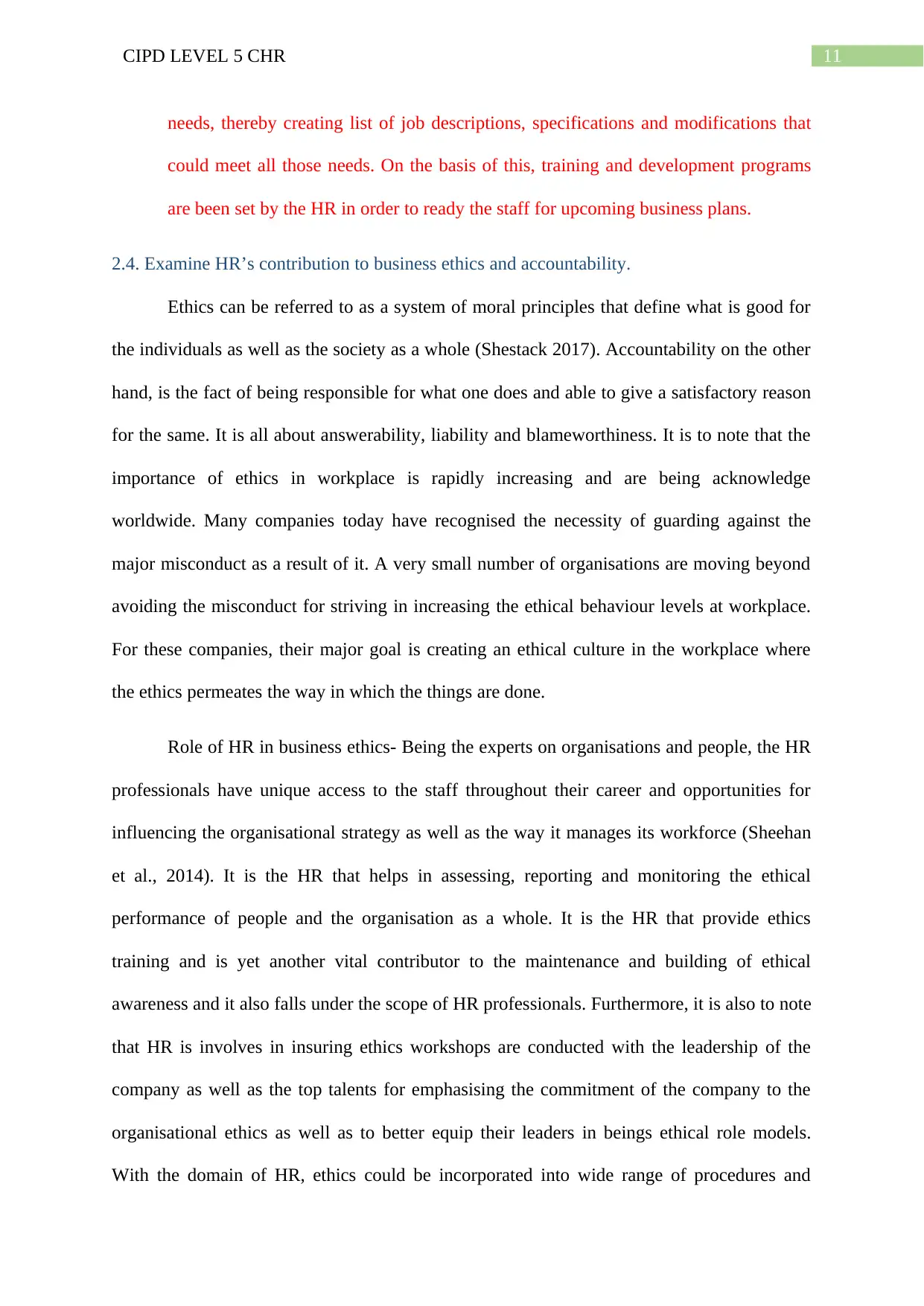
11CIPD LEVEL 5 CHR
needs, thereby creating list of job descriptions, specifications and modifications that
could meet all those needs. On the basis of this, training and development programs
are been set by the HR in order to ready the staff for upcoming business plans.
2.4. Examine HR’s contribution to business ethics and accountability.
Ethics can be referred to as a system of moral principles that define what is good for
the individuals as well as the society as a whole (Shestack 2017). Accountability on the other
hand, is the fact of being responsible for what one does and able to give a satisfactory reason
for the same. It is all about answerability, liability and blameworthiness. It is to note that the
importance of ethics in workplace is rapidly increasing and are being acknowledge
worldwide. Many companies today have recognised the necessity of guarding against the
major misconduct as a result of it. A very small number of organisations are moving beyond
avoiding the misconduct for striving in increasing the ethical behaviour levels at workplace.
For these companies, their major goal is creating an ethical culture in the workplace where
the ethics permeates the way in which the things are done.
Role of HR in business ethics- Being the experts on organisations and people, the HR
professionals have unique access to the staff throughout their career and opportunities for
influencing the organisational strategy as well as the way it manages its workforce (Sheehan
et al., 2014). It is the HR that helps in assessing, reporting and monitoring the ethical
performance of people and the organisation as a whole. It is the HR that provide ethics
training and is yet another vital contributor to the maintenance and building of ethical
awareness and it also falls under the scope of HR professionals. Furthermore, it is also to note
that HR is involves in insuring ethics workshops are conducted with the leadership of the
company as well as the top talents for emphasising the commitment of the company to the
organisational ethics as well as to better equip their leaders in beings ethical role models.
With the domain of HR, ethics could be incorporated into wide range of procedures and
needs, thereby creating list of job descriptions, specifications and modifications that
could meet all those needs. On the basis of this, training and development programs
are been set by the HR in order to ready the staff for upcoming business plans.
2.4. Examine HR’s contribution to business ethics and accountability.
Ethics can be referred to as a system of moral principles that define what is good for
the individuals as well as the society as a whole (Shestack 2017). Accountability on the other
hand, is the fact of being responsible for what one does and able to give a satisfactory reason
for the same. It is all about answerability, liability and blameworthiness. It is to note that the
importance of ethics in workplace is rapidly increasing and are being acknowledge
worldwide. Many companies today have recognised the necessity of guarding against the
major misconduct as a result of it. A very small number of organisations are moving beyond
avoiding the misconduct for striving in increasing the ethical behaviour levels at workplace.
For these companies, their major goal is creating an ethical culture in the workplace where
the ethics permeates the way in which the things are done.
Role of HR in business ethics- Being the experts on organisations and people, the HR
professionals have unique access to the staff throughout their career and opportunities for
influencing the organisational strategy as well as the way it manages its workforce (Sheehan
et al., 2014). It is the HR that helps in assessing, reporting and monitoring the ethical
performance of people and the organisation as a whole. It is the HR that provide ethics
training and is yet another vital contributor to the maintenance and building of ethical
awareness and it also falls under the scope of HR professionals. Furthermore, it is also to note
that HR is involves in insuring ethics workshops are conducted with the leadership of the
company as well as the top talents for emphasising the commitment of the company to the
organisational ethics as well as to better equip their leaders in beings ethical role models.
With the domain of HR, ethics could be incorporated into wide range of procedures and
⊘ This is a preview!⊘
Do you want full access?
Subscribe today to unlock all pages.

Trusted by 1+ million students worldwide
1 out of 23
Related Documents
Your All-in-One AI-Powered Toolkit for Academic Success.
+13062052269
info@desklib.com
Available 24*7 on WhatsApp / Email
![[object Object]](/_next/static/media/star-bottom.7253800d.svg)
Unlock your academic potential
Copyright © 2020–2025 A2Z Services. All Rights Reserved. Developed and managed by ZUCOL.





